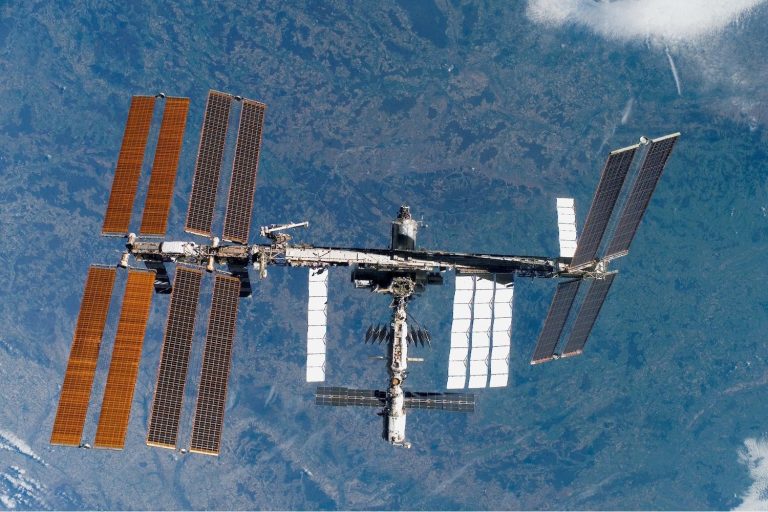
Ushering a New Design for Communications Satellites: Q&A with AST SpaceMobile’s Scott Wisniewski (Image Credit: Payload)

By David Bullock
Staff Writer
This past weekend, AST SpaceMobile’s BlueWalker 3 communications satellites was deployed in low Earth orbit after a successful launch aboard a Falcon 9 rocket. Parabolic Arc was able to talk Scott Wisniewski, Chief Strategy Officer at AST Mobile, about BlueWalker 3 and the company’s plans for a constellation of broadband satellites that will connect directly with cellular phones worldwide.
Could you tell me a little about your background?
Sure, I started my career as an engineer and then later into supply chain. I spent little over a decade as an investment banker in New York raising money for telecom companies, satellite companies and space companies in general. I raised all the money for AST SpaceMobile including their Series B, which brought in Vodafone, American Tower, Samsung and Rakuten. And then I put together the SPAC deal that brought AST public, raised another $460 million and then I joined the company after the deal closed as Chief Strategy Officer with responsibility for [investor relations, public relations,] treasury and corporate development.
What makes the BlueWalker3 (BW3) significant?
Well, it’s a mission that will facilitate our company’s strategy, which is to connect regular phones to satellites directly in low Earth orbit with cellular broadband. And that’s unmodified cell phone 4G/5G… There’s five billion globally and our intent is to connect to them.
Speaking more broadly, I think the mission is pretty important and historic, because once we unfold the array, it will be the largest communications array ever commercially deployed into low Earth orbit. So, it’s 692 sq ft. [64.3 sq m] A large communications array, a large antenna is important in order to connect directly to weak, low-powered phones, the ones that we use for terrestrial usage… So, it’s a pretty important milestone for the development of space and how we are doing it.
What is the status of the BW3 mission as of today, September 13?
We launched it on Saturday directly into an orbit of 513 km low Earth orbit at an inclination of 53 degrees. We made communications with the satellite shortly after it was released from the rocket, and we have been tracking with telemetry ever since. We were also able to stabilize the spacecraft and put it into a thermal roll, which means that it’s within our control and we could continually point it at the Sun so that it recharges the batteries, and we can start bringing systems online. In the coming weeks we want to unfold the array. It’s currently compressed into about a cube, which is how we launched it. After we unfold it, we will start doing testing and configuration on our end and do our first calls to the satellite.
Ultimately, the mission is to do testing with our mobile network operator partners. Our go-to market strategy is wholesale to the global mobile network operators, like Vodafone, AT&T, Orange and MTN, really big companies who have hundreds and millions of subscribers all around the world. So, we’ll be doing testing with a lot of these guys, with this satellite. And that testing means there’ll be configuring their network boards to interconnect with our traffic, so they will be able to have commercial grade service when we roll out our full constellation. And we’ll be doing this testing on all six continents.

Where is your customer base for BW3 technology?
This is a test satellite, so this is to configure the ground infrastructure. But once we start launching our commercial satellites, our go-to market strategy is pretty simple and we target two groups of folks. One, is the [group of people who] work and travel and are going in and out of coverage every day. This can be all around the world where people experience gaps in coverage anywhere there is not terrestrial coverage today.
And the other group of people is folks that don’t have access to cellular or broadband today. There are 3.7 billion people globally that don’t have access to cellular broadband, which is defined as 3G or better. And there is another 450 million people who don’t have access to any cellular infrastructure. So, those are the two big, broad sets of people that we think we’ll be able to service and together collectively they fill in that 5 billion mobile phones that are in use today around the world.
The go-to market strategy will vary country by country. Our technology is very flexible and allows us to basically deliver bits through our mobile network operators’ infrastructure to their users. And allow their users to seamlessly connect to our satellites directly and when they are out of coverage, they will get a text. And if they select yes, they’ll be on our network and that arrangement of structure and revenue shift so they will pay from then on to their carrier. And then their carrier will share that with us. So that is the market for our service.
Tell me a little about the investments made for this mission.
So, we invested $85 million directly into the BlueWalker 3 satellite. Most of that was one time R&D. We’ve been at it for about two years, designing and manufacturing the BlueWalker 3 satellite. Over the life of our company, we have raised $600 million, and we’ve made significant investments in our people and growing the company.
In our relationships, we have relationships with over 25 mobile network operators globally, who collectively cover over 1.8 billion subscribers. And we also have two manufacturing sites in Texas that are going to help us achieve our goal in the future of manufacturing six satellites per month.
So, we’ve made a significant amount of investments in our technology, in our people, in our organization, and in our manufacturing. Our investment in technology yielded over 2,400 patents and patent pending claims for this novel technology. And ultimately, we are going to launch this satellite and reap the benefits from that.
What sets AST’s technology apart from other potential space mobile communications companies?
When you look at space in general there’s lots of excitement, right? But if you look at the revenue and the market for space, it is mostly telecommunications. I know there is launch, manufacturing and then there’s ground infrastructure. But most of the money is in telecommunications and telecommunications services. Within that you have sat phones, which is a pretty small market. And then you’ve got broadband communications through a dish, which is a much bigger market enough than most of us play. Those are like $2 billion and $20 billion sized markets respectively. The market we play in is wireless services which is the sum of wireless plans paid by those five billion mobile phones globally and that’s over a trillion dollars. We aim to compete in the wireless services market on a cellular basis. Folks are throwing their hat in the ring around connecting directly to cell phones, but we think that we’re differentiated based on the service we’re deciding to offer, which is 4G/5G cellular broadband.
What is the antenna size?
It’s 692 sq ft [64.3 sq m] phased array antenna, once unfolded. That allows us to connect over long distances directly and with high quality and good throughput to regular phones that are totally unmodified. It is going to be the largest communications array ever commercially deployed into low Earth orbit. And it is important that it is going to connect with low powered spectrums.
What will be the size of the constellation?
Ultimately, we will start with 168 satellites globally. Importantly we’ve segmented the constellation, so we can build it in pieces. Most recently, we are going to be launch five more satellites next year, which will support an intermittent service. But ultimately, we want to have 20 satellites to cover the equator with continuous service. And we want about 60 satellites to cover the United States, Europe and Spain and 90 total satellites will get us global coverage. After that we can also launch another 58 satellites which gives us [NEtwork Mobility] coverage over high throughput strong market, and I think that is the total of 168. The segments are networked so we can build them in pieces and develop revenue and cash flow before the completion of the whole network.
How do you see notable competition from Apple or Lynk?
Well, I only know what I read in the press, but we don’t really run into them with our customers. We have over 25 potential customers signed up to an agreement through MOUs. Through them we have access to over 1.8 billion subscribers. We really don’t see these other folks in the market. We see them as being in the marketplace. Their service tends to be text based or emergency based. And we are firmly targeting 4G/5G cellular broadband, with which we’ve signed with Nokia as a partner. We’ve signed up an agreement with Nokia to give us space station infrastructure that is used more commonly in cellular plans. And we’ll be using their 4G/5G hardware and modified software to interconnect with the [mobile network operators]. So, we can deliver 4G/5G service to their customers, the end users, and give them access to cellular broadband.
What does the BW3 mission mean for astronomy?
I think it is very innovative and it represents what a satellite should look like. Historically, satellites tend to be a large center unit with a couple of arms that have solar panels and antennas. And this is really a very elegant design in that it is entirely an antenna on one side and entirely a solar panel on the other. So, it is a very efficient way to collect a lot of power and also to distribute a signal. And at the same time, it’s very thin in its profile. So, when it circles the Earth, it has a very slim profile. It’s a very innovate satellite design and effort of its kind and I think it will facilitate a new approach collecting power and delivering signs to space.
How does this mission translate to the future of space-based communication?
Well, building on my last answer, I think the satellite design itself is quite innovative. Our patented approach to managing delay and Doppler is also very innovative because it allows for the first-time satellites to connect over long distances to a phone. A mobile phone that uses the 3GPP standard effectively time out after five, ten, twenty milliseconds. And low Earth orbit has a latency of twenty to forty milliseconds.
We had a couple of innovations. One is our patented delay and Doppler fix, which encourages our phone to wait long enough for the signals to come back. And our satellite design, which is a [wide, thin modular design of solar tiles] that collect solar power. So, I think we done some innovation on the satellite design. We’ve done innovation on the way those signals are delivered to Earth. And we’ve also mirrored cellular architecture to the greatest extent possible. If you look at how cell phones communicate with towers, and in fact the network for the mobile network operator, we’ve mirrored that architecture very closely and captured all the key functions, some on the satellite and some on the ground, using the same infrastructure that the mobile network operators using for terrestrial [communication].
Is there anything you’d like to add?
I think one important approach that we have is that we’ve partnered with the mobile network operators. We have a revenue share business model with them. And that allows us to bring the space-based network and the technology, and they bring the customers and the spectrum. By organizing ourselves that way it very symbiotic to the mobile network operators. And we’re not at all competitive. In fact, our biggest investors are Vodafone, who’s invested twice—they are the largest cell carrier outside of China globally, American Tower, who’s invested twice—they are the largest cell tower company in the world, Rakuten who’s invested twice—they’re the largest e-commerce platform outside of Asia and Samsung as well. We have a really good group of partners and investors who can support this mission.








